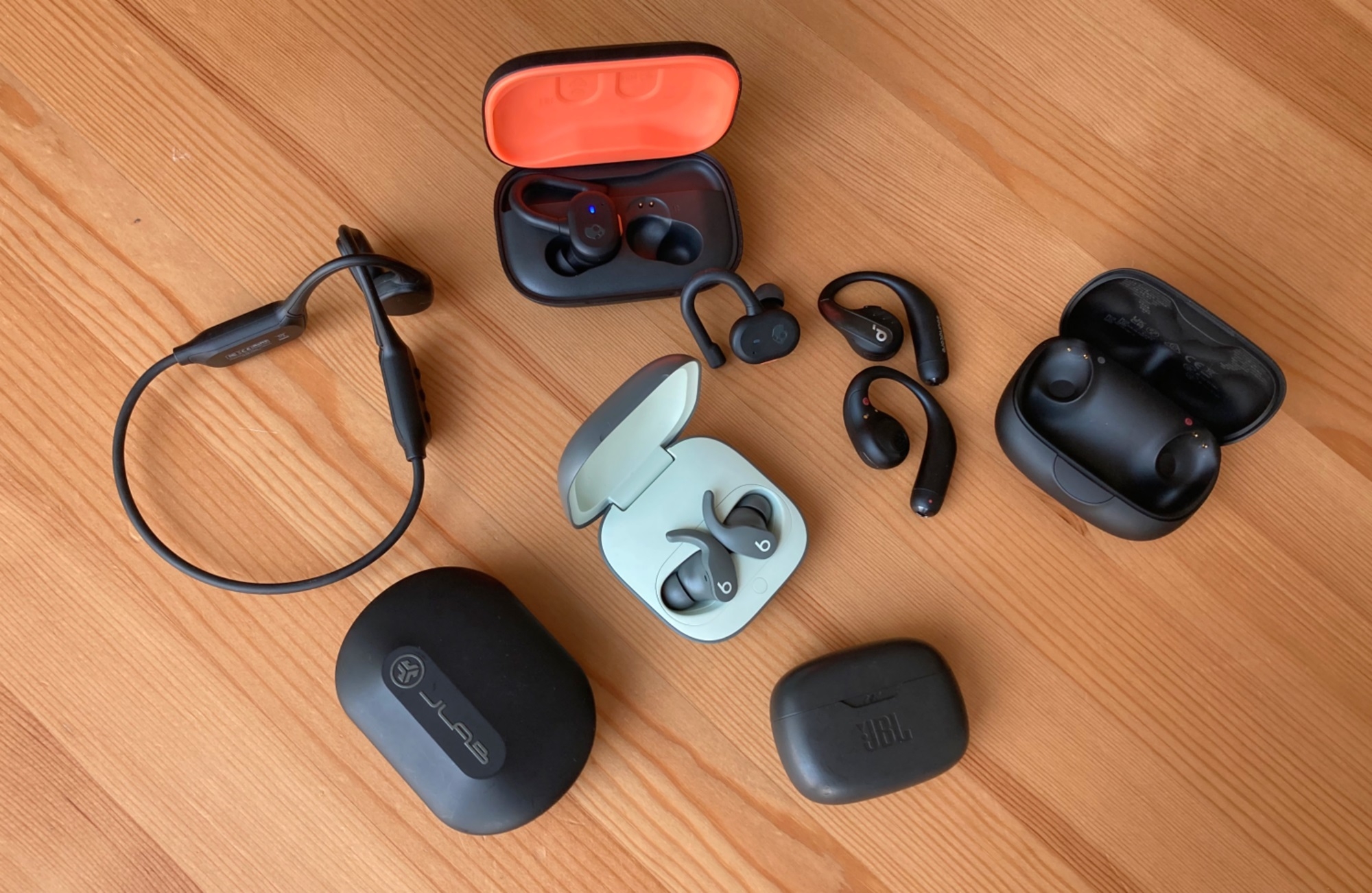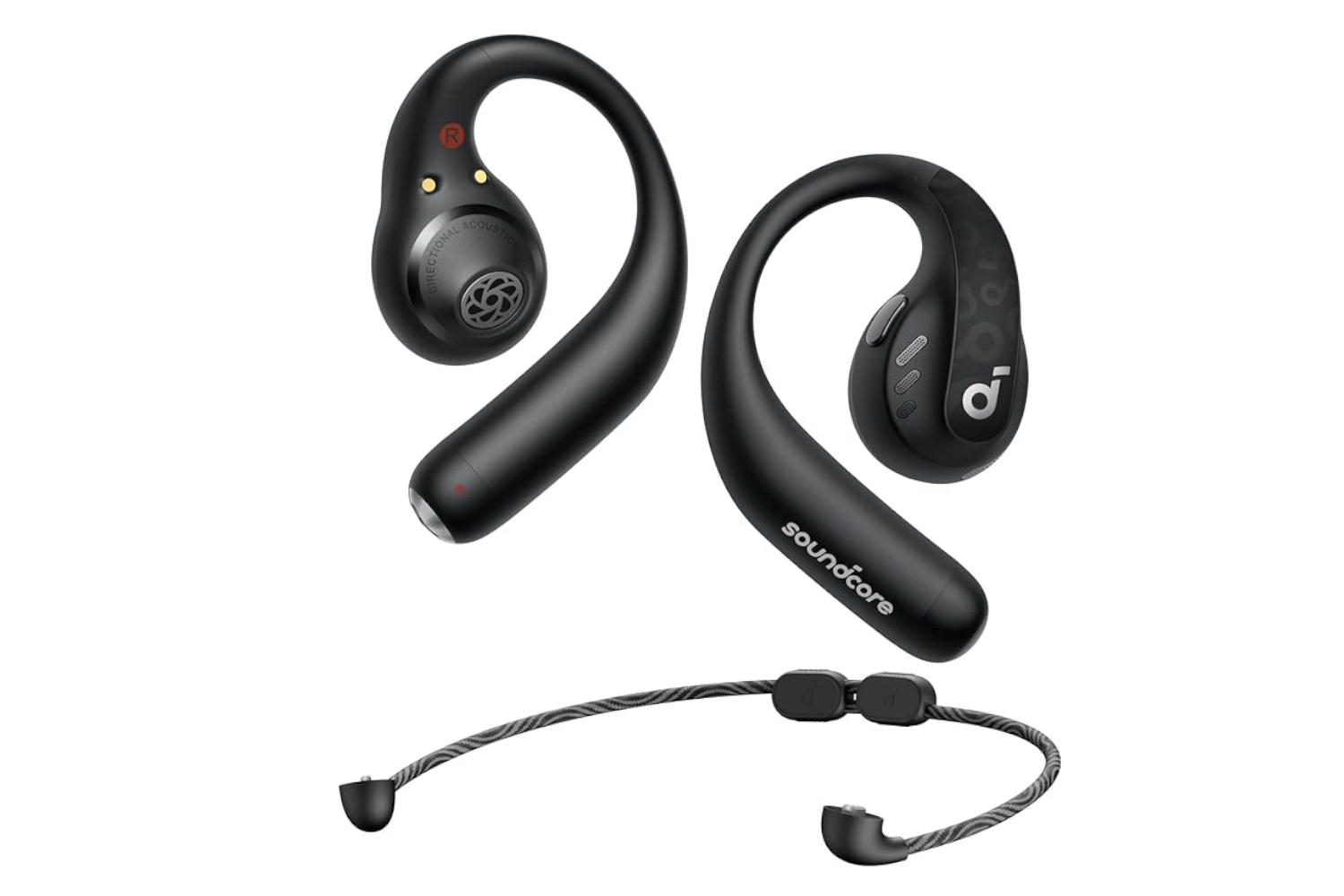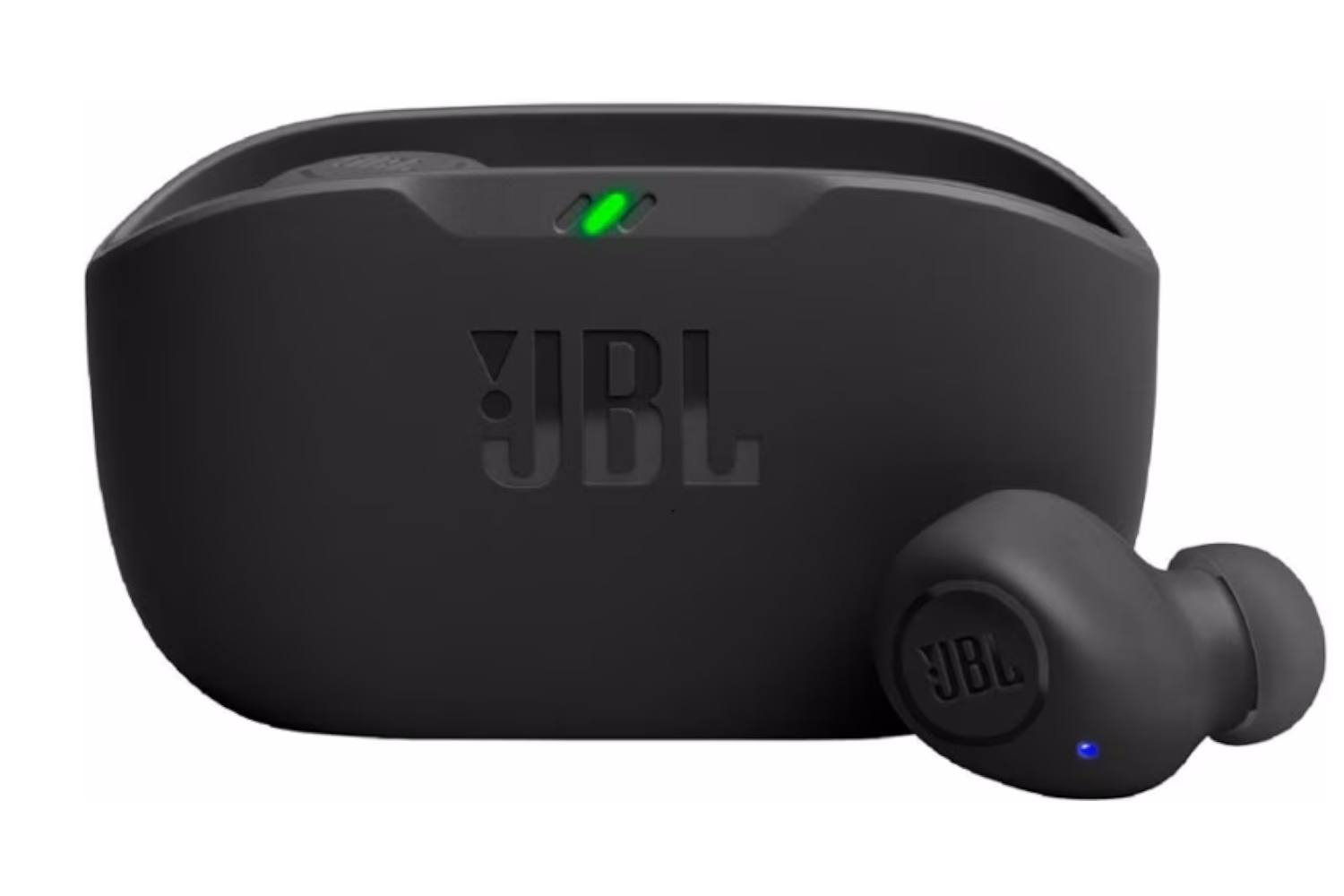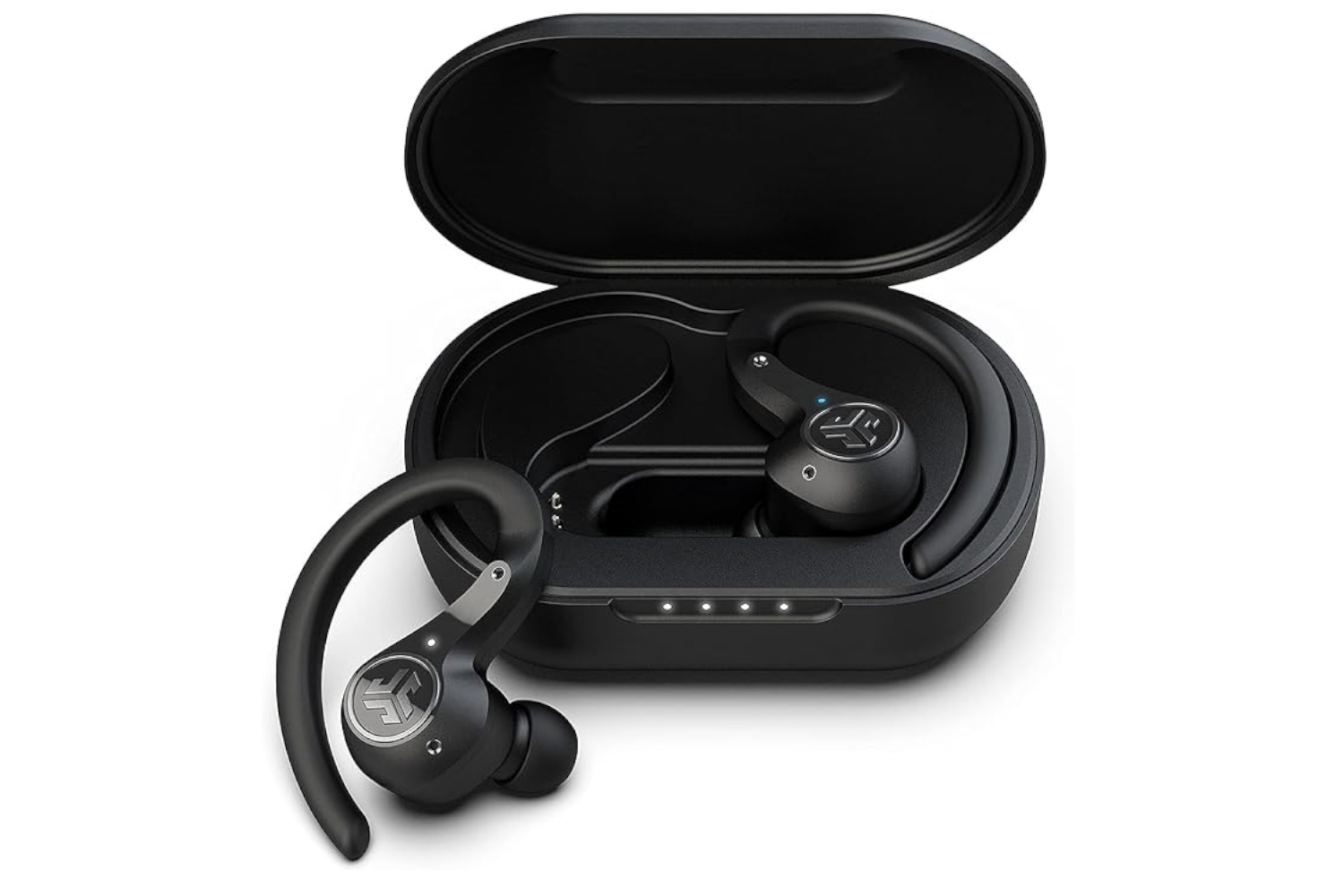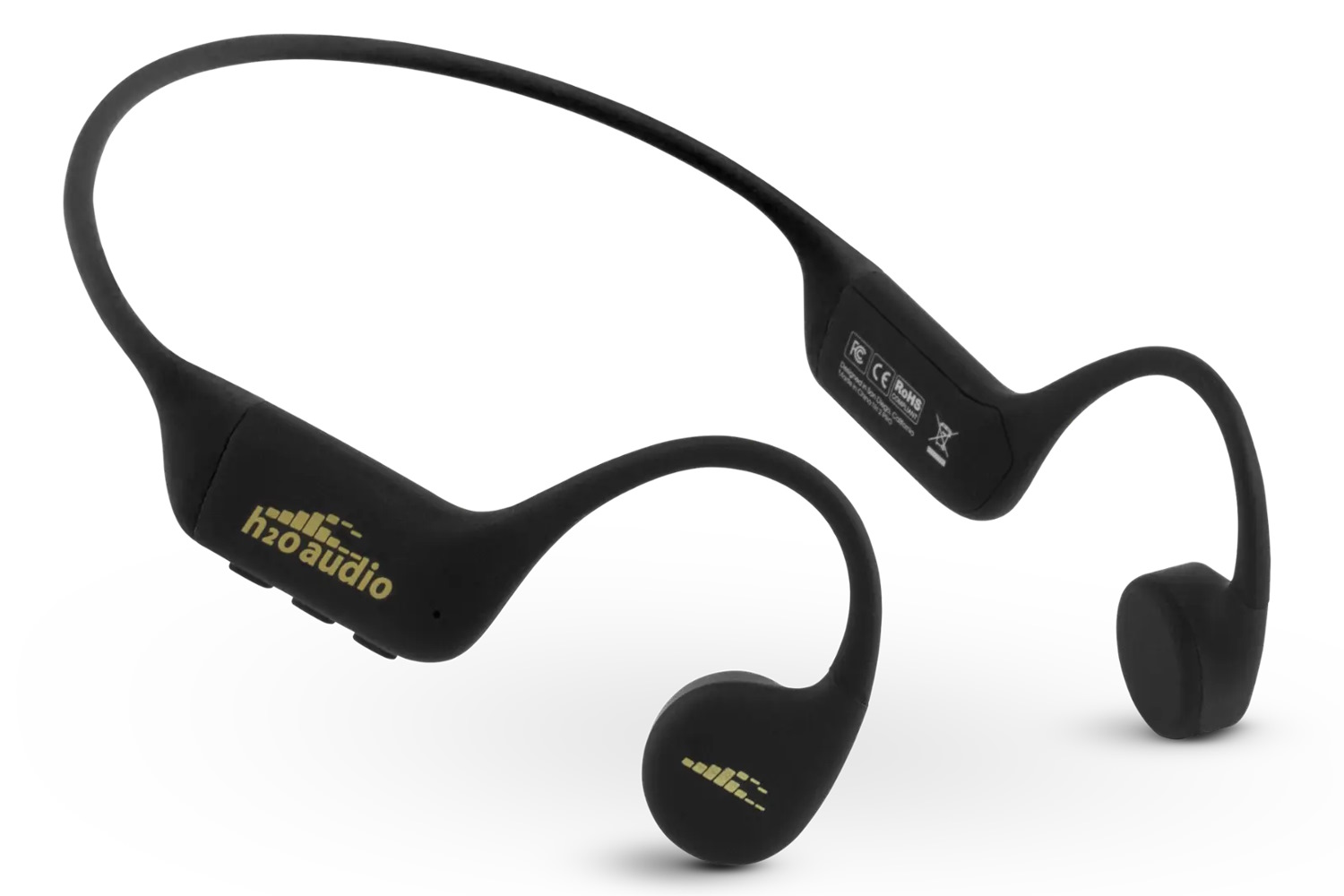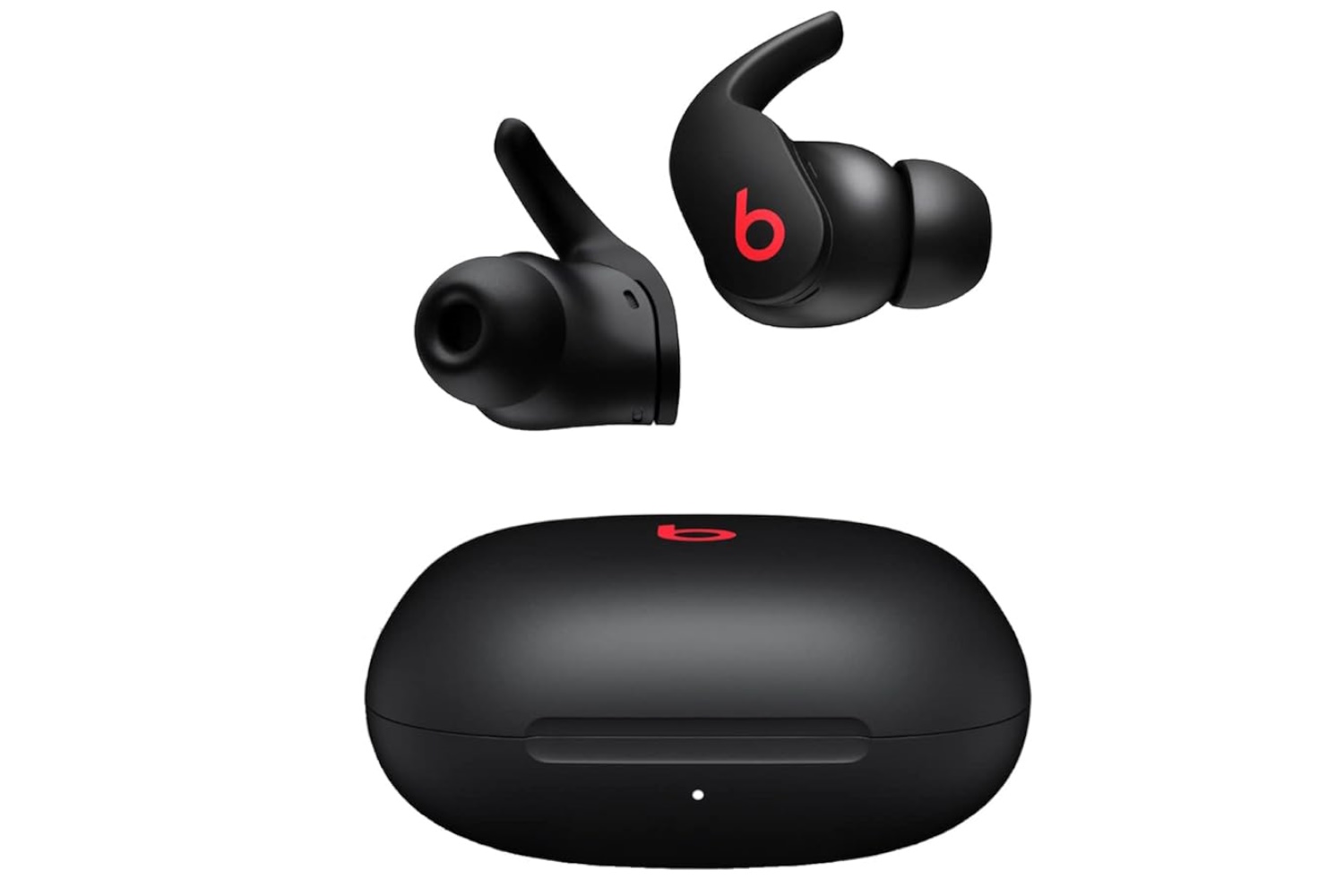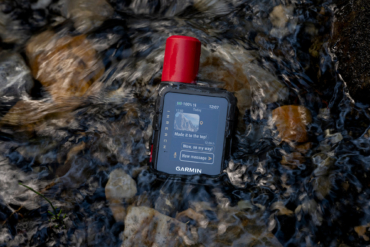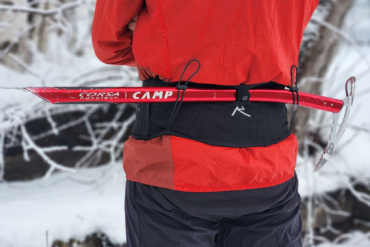Buying the best running headphones can be a dice roll. Virtually all of us use them, but these techy tidbits come in all over the board. Depending on what you’re doing, they can miss the mark. The best running headphones provide strong field performance like fit and durability. Condition-specific factors — touch functionality, water resistance, and connectivity — could make or break anyone’s hype on a run.
How can you be sure whether the headphones you’re thinking about will stay put if you take a spill, go parkour, or run during an earthquake? And if you’re going the distance on a triathlon or ultramarathon, will your headphones’ batteries survive? Do you need a wraparound headphone like the Soundcore Aerofit Pro? Will an in-ear headphone like the Beats Fit Pro stay in on bumpy trail runs? Do bone-conduction headphones like the H2O Audio Tri 2 Pro actually work? We hit the road (and trails) to answer those questions.
GearJunkie’s testers have cut trails and pounded pavement since the days when wearable heart measurement technology was novel. To find the best running headphones of 2024, we tested buds on choppy trails in Texas and crowded city streets in southeast Asia. With dozens of earbud tests under our belts, we identified six of the best running headphones for this best-of list. If you’re looking for more info on picking the right pair for you, check out our Buyer’s Guide, Comparison Chart, and Price & Value sections.
Editor’s Note: We updated this guide on October 28, 2024, by adding the updated H2O Audio Tri 2 Pro and beefing up our buyer’s guide content.
The Best Running Headphones of 2024
- Best Overall Running Headphones: Soundcore Aerofit Pro
- Best Budget Running Headphones: JBL Vibe Beam
- Best-Fitting Running Headphones: JLab Epic Air Sport
- Best Waterproof Running Headphones: H2O Audio Tri 2 Pro
- Best Sounding Running Headphones: Beats Fit Pro
- Best Mid-Range Running Headphones: Skullcandy Push Active
Soundcore AeroFit Pro
- Battery Life: 14 hours (tested), 46 with case (claimed)
- Weight: 95.5 grams (with recommended neckband)
- Water Resistance: IPX5
- Features: Detachable neckband, Customizable EQ or spatial audio
Pros
- No pressure points
- Good balance between earphone sound and ambient sound
- Comfortable adjustable neckband design
- Long battery life
Cons
- Loose fit without neckband
JBL Vibe Beam
- Battery Life: 8 hours (tested), 32 with case (tested)
- Weight: 48.4 grams
- Water Resistance: IP54
- Features: JBL Headphones app compatibility
Pros
- Durability
- Water resistance
- Very carryable, tightly-built case
- Long-term reliability
Cons
- Can jostle loose
- Easy to activate touch controls while adjusting the fit
JLab Epic Air Sport
- Battery Life: 15 hours (claimed), 50+ with case (claimed)
- Weight: 96.3 grams
- Water Resistance: IP66
- Features: 3-setting ANC, Integrated charging cable, Customizable touch control
Pros
- Secure over-ear fit
- Loud
- Good voice call function
Cons
- The case takes up lots of room
- Little difference between ANC/non-ANC
H2O Audio Tri 2 Pro
- Battery Life: 6-8 hours (tested)
- Weight: 31.5 grams
- Water Resistance: IPX8
- Features: On-board playlist function, Swim-friendly
Pros
- Very easy to hear surrounding noise
- Tight waterproofing
- Listening doesn’t require paired device
- High voice call quality
Cons
- Sound not as clear as other headphones on this list
- Proprietary charging port
Beats Fit Pro
- Battery Life: 6 hours (tested), 24 with case (claimed)
- Weight: 66.1 grams
- Water Resistance: IPX4
- Features: In-ear wingtips, ANC Siri compatibility, Biomapped EQ, Find My
Pros
- Extremely high sound quality
- Tight fit, in-ear profile
- Easy touch control
- Very strong ANC, very penetrable non-ANC
Cons
- Moderately low battery life
- Loose case construction
Skullcandy Push Active
- Battery Life: 10 hours (claimed), 44 with case (claimed)
- Weight: 93.5 grams
- Water Resistance: IP55
- Features: Voice control, Find My, Customizable EQ
Pros
- Easy to dial in fit
- Loud
- Easy voice commands
- Fun app functions
Cons
- Bluetooth wasn’t perfect during test
- Stay Aware function sounded windy
Running Headphone Comparison Chart
| Running Headphones | Price | Type | Battery Life | Weight (with case) | ANC |
|---|---|---|---|---|---|
| Beats Fit Pro | $200 | In-ear, secured | 6 hours, 24 with case | 66.1 grams | Yes |
| JBL Vibe Beam | $45 | In-ear | 8 hours , 32 with case | 48.4 grams | No |
| JLab Epic Air Sport | $100 | In-ear, secured | 15 hours, 50+ with case | 96.3 grams | Yes |
| H2O Audio Tri 2 Pro | $19 9 | Bone conduction | 6-8 hours | 31.5 grams | No |
| Skullcandy Push Active | $90 | In-ear, secured | 10 hours, 44 with case | 93.5 grams | No |
| Soudcore AeroFit Pro | $170 | Open-ear | 10 hours, 44 with case | 95.5 grams (with recommended neckband) | No |

How We Tested the Best Running Headphones
Our Expert Testers
GearJunkie’s runners have tested hundreds of men’s and women’s products on trails, in busy urban centers, and during competitive Adventure Racing. 2024’s running headphones tests built on that theme, with our testers ranging from Texas trails to central California, Singapore, and Thailand.
The testers for this article have combined experience of over 20 years in middle-distance trail running, competitive track racing, and multi-sport activities like CrossFit. Our editorial team includes GearJunkie Adventure Racing team members, and editors for iRunFar.com provided product consultation.
We’re also real people, so we use headphones just like everyone else — running errands, attending meetings, and taking phone calls. We worked out, traveled, and vibed out to music in our running headphones. One improvised water resistance test took place when we forgot a pair of earbuds in a shorts pocket and threw the shorts in the washing machine.
Our Testing Process
Performance demanded resilience under extreme heat (up to 95 degrees at 80% humidity on the Singapore streets) and during travel. City traffic, sweaty ears, and logistics of battery life and case carrying were constant factors. Testers put water resistance to the test in events including moderate-distance swim training and sauna & cold plunge recovery sessions.
Testing periods ranged from months to years. We discharged and recharged headphones frequently and retested units to find our favorite applications for each product. Testers used their assigned headphones during recreational runs but considered possible uses during competitions within rule allowances.
Buyer’s Guide: How to Choose Running Headphones
Fit/Comfort
Even if you only go on short, half-hour jogs, the wrong-fitting headphones can still give you an earache. That said, it’s not always as simple as picking the set of rubber tips that feel the best and popping the headphones in. Pain from earbuds can come from the tips, over-ear or concha ridge hooks, or even constant re-adjustment.
Look for springy but flexible ear hooks like the ones on the JLAB Epic Air Sport, or a bone conduction set like the H20 Audio Tri Pro. For most, Apple AirPods can be a good choice — but because there’s no fit adjustment, there’s some possibility you’ll find yourself constantly fiddling with them to keep them snug.
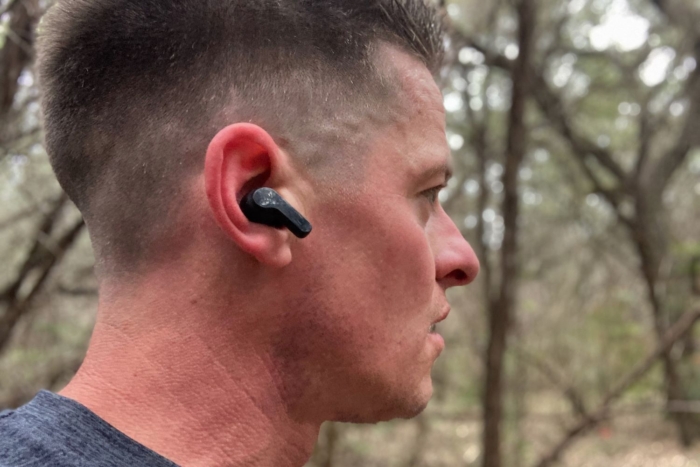
Battery Life
Not every runner needs best-in-class headphone battery life, like the JLab Epic Air Sport provides. To be honest, most of us can’t run for 10 or more hours straight, no matter if we want to or not. But it’s always best to consider how else you’ll use your headphones outside workouts and what it takes to recharge them if the worst happens.
If you’re a daily commuter with an office job and an after-work running routine, consider headphones with long battery life on a single charge. It’s possible you’ll want more than 4 to 6 hours of listening time per day, and it’s easiest not to recharge unless you have to.
If you’re a marathoner, we’d encourage the same thing — start your run or race with a full charge and save precious grams by leaving the case behind.
If you’re a hardcore adventure runner who can do 30, 50, or 100+ miles, look for quick recharge time and a well-built, compact case. You might not hit 0% on your run, but your headphones likely will.
Touch/Voice Controls
The key to success in headphone touch controls for runners: simplicity.
Most of us don’t want to think about anything while we’re running. Others get their best thinking done while they’re knocking out miles. The common denominator is that the last thing any of us want to think about is how many taps it takes on which ear to activate what function.
“OK, so do I tap my left earbud three times for the last track, twice slowly then once quickly to activate voice control, and one-touch followed by two clicks to toggle ANC? Or is it only once slowly then twice …”
Nobody wants that. Our staff also prefers button or voice control over touch control. It may be common for runners to scratch itches, wipe sweat from their faces, etc. Pawing a touch-activated earbud repeatedly can lead to functional frustration. We got along well with the Skullcandy Push Active voice assistant and button controls.

Noise Canceling or Non-Noise Canceling
Active noise canceling (ANC) headphones have skyrocketed in popularity as the technology has improved in smaller and smaller packages. ANC uses one or more microphones to collect, measure, and “cancel” incoming sound by producing counteracting sound waves.
So, do you need ANC in running headphones? Safety-conscious, urban runners or those who just like listening to the birds and the bees may resist it. As our testing revealed, some of today’s ANC is extremely potent, making it impossible to hear normal noises anywhere nearby. It can be intimidating.
However, audiophiles or runners who prefer to zone out can revel in the sonic focus ANC provides. To jam out on music and let the vibes take over (testing or otherwise), our testers reach for the loudest pair of ANC headphones. The technology pairs especially well with the surge in custom equalizer tools for headphones . And if you’re ably sighted, you can always keep your head on a swivel to keep yourself safe.
In-Ear or Open-Ear
Each of these categories carries one main drawback and one main advantage. Headphones with in-ear designs sound louder but can become painful after hours of wear. Open-ear designs are more comfortable, but never bring the same thump as in-ear buds.
Runners can consider mileage to help call a shot. Do you really want anything in your ears for 10, 24, or 30+ hours? Not all in-ear buds are created equal, it’s true — and the better the fit, the less earache you’ll face. But the advantage of open-ear buds over extended wear periods is that there’s actually a possibility you’ll forget you’re wearing them. Not only that, but you’ll also stay more directly tuned to the outside world. The Soundcore Aerofit Pro showed very balanced open-ear sound quality during our tests.
On the other hand, the whole reason you run might be that you like getting lost in your own world. In that case, an in-ear set can better defend your groove from the ingress of external hassles we all navigate.
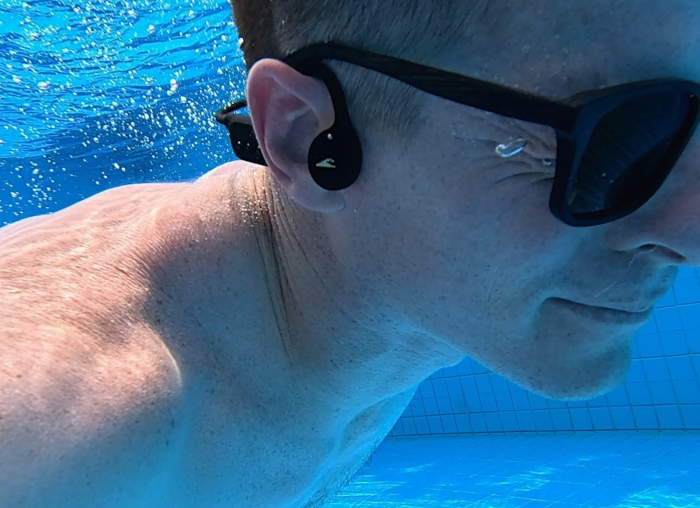
Water Resistance/Ingress Protection
The IP system strikes again! Remember, look at the last two digits (either an X and a number or two numbers). The first digit stands for dust and debris resistance, the second is water. The common IP54 means that it can let in some dust but not enough to hurt the device (5), and that it’s protected from splashing water (4).
Anything beyond this, and you’ve got a pretty robust earbud for running. IPX5 is water jet-protected, and IPX6 gear won’t yield to “powerful water jets” or “heavy seas.”
Price & Value
Budget
If you’re looking for a budget pair of running headphones, you can expect to spend anywhere up to $100. You can also expect to find some compromises on durability and sound quality. But there are some budget steals out there, like the JBL Vibe Beam ($45). Despite its low price, the 8-hour battery life and good sound quality were pleasant surprises. We did find that they had a tendency to jostle free during runs, but for $45, they’re a solid pair.
Mid-Tier
The middle tier of running headphones ranges in price from $100 to $175 and offers higher sound quality and a few other interesting features. The JLab Epic Air Sport ($100) is at the low end of this tier and offers excellent mid-range sound quality and a secure, comfortable fit on long-distance runs. The Soudcore AeroFit Pro ($170) lies near the top of this price range, but delivers up to 14 hours of battery life and excellent sound quality.
Premium
You can expect to spend $200 or more on top-tier running headphones. At this price range, you’ll find specialty headphones like the waterproof H2O Audio Tri 2 Pro ($199), a set of bone-conduction headphones designed for wear during swim training. If sound quality is your priority, the Beats Fit Pro ($200) delivers some excellent boom and extremely clear sound. Plus, the ANC quality is one of the best of any headphones we’ve tested.
Frequently Asked Questions
Headphones with rubber or silicone hooks that loop over the top of the ear are likely to inspire the most confident fit in the category. But that doesn’t mean other types will just fall out willy-nilly.
Beats Fit Pro’s “wingtips” provided a tight fit in our testing. The tips hold pressure against the inner ear ridge which, while not super comfortable over time, was unquestionably secure.
In open-ear sets, neckbands not only help keep a set together if you take a tumble, but also add positional stability. The H2O Audio Tri Pro even includes a rubber leash you can attach to your glasses or goggles during races or swimming.
Running safety questions virtually always have situational answers. (Is it safe to run without water? If you’re in a busy city, sure — if you’re in the Moroccan desert, not so much. And so on.) This is one of those questions.
Depending on your running conditions, you could need a pretty disparate kit to keep yourself safe. Let’s say you’re in the suburbs, running on straight-line sidewalks that border 45 mph traffic. In this case, our testers reach for an open-ear set. It’s safety first in traffic, and we want to key in on it as far in advance as possible.
While testing trail running in a remote area, our testers might pick up their favorite ANC headphones and let the trail lead the way. That could change, though, depending on traffic. Mountain bikers or one-wheel riders can come up quick — especially on switchback terrain or in narrow corridors — and nobody wants to jam up traffic or, worse, hit the dirt in a heap.
Also be smart about wildlife. Make noise as you run in remote areas with large predators, and stay aware of your surroundings.
Though we’ve heard stories of some especially slimy athletes killing headphones with sweat, most of us won’t come anywhere close.
Most running headphones are built to survive light rain, and some go beyond that. There’s plenty of crossover between running, triathlon, and paddling sports, and standards for water resistance can be very high. Check out the H2O Audio Tri Pro’s IPX8 rating, which helps it survive permanent submersion in water up to 13 feet.
Sweat hits different, though — can the salty, particulate discharge from our pores corrode earbud components even worse? The upshot is that prolonged exposure to moisture can cause electrical problems, like refusal to charge. This can take years.
Your best bet is to let your headphones air dry, outside the case, after a soggy run. This should keep the connections and any ingress points clean and functional — both on the buds and inside the case.
They can last anywhere from 6 to 14 hours on a single charge and at least 24 with a fully charged case. The JLab Epic Air Sport claims the burliest battery in our test, at 15 hours in the buds and 50+ combined with the case.
Carefully and according to the manufacturer’s instructions. Tools of the trade basically include lint-free cloths and/or Q-tips, warm water, and isopropyl alcohol (in some cases). Cleaning eartips is simple enough. One tester sometimes uses a toothbrush or paperclip to gently lift out any grime inside microphone ports or speaker housings.
Unit-specific instructions from most manufacturers are available via a basic Google search.
